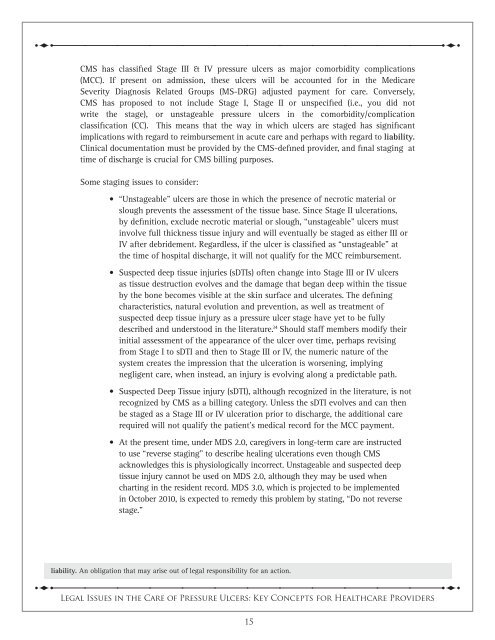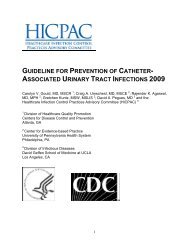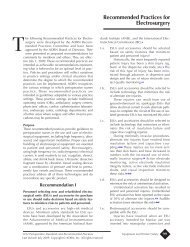Legal Issues in the Care of Pressure Ulcer Patients - Medline
Legal Issues in the Care of Pressure Ulcer Patients - Medline
Legal Issues in the Care of Pressure Ulcer Patients - Medline
Create successful ePaper yourself
Turn your PDF publications into a flip-book with our unique Google optimized e-Paper software.
sttttttttttttsCMS has classified Stage III & IV pressure ulcers as major comorbidity complications(MCC). If present on admission, <strong>the</strong>se ulcers will be accounted for <strong>in</strong> <strong>the</strong> MedicareSeverity Diagnosis Related Groups (MS-DRG) adjusted payment for care. Conversely,CMS has proposed to not <strong>in</strong>clude Stage I, Stage II or unspecified (i.e., you did notwrite <strong>the</strong> stage), or unstageable pressure ulcers <strong>in</strong> <strong>the</strong> comorbidity/complicationclassification (CC). This means that <strong>the</strong> way <strong>in</strong> which ulcers are staged has significantimplications with regard to reimbursement <strong>in</strong> acute care and perhaps with regard to liability.Cl<strong>in</strong>ical documentation must be provided by <strong>the</strong> CMS-def<strong>in</strong>ed provider, and f<strong>in</strong>al stag<strong>in</strong>g attime <strong>of</strong> discharge is crucial for CMS bill<strong>in</strong>g purposes.Some stag<strong>in</strong>g issues to consider:• “Unstageable” ulcers are those <strong>in</strong> which <strong>the</strong> presence <strong>of</strong> necrotic material orslough prevents <strong>the</strong> assessment <strong>of</strong> <strong>the</strong> tissue base. S<strong>in</strong>ce Stage II ulcerations,by def<strong>in</strong>ition, exclude necrotic material or slough, “unstageable” ulcers must<strong>in</strong>volve full thickness tissue <strong>in</strong>jury and will eventually be staged as ei<strong>the</strong>r III orIV after debridement. Regardless, if <strong>the</strong> ulcer is classified as “unstageable” at<strong>the</strong> time <strong>of</strong> hospital discharge, it will not qualify for <strong>the</strong> MCC reimbursement.• Suspected deep tissue <strong>in</strong>juries (sDTIs) <strong>of</strong>ten change <strong>in</strong>to Stage III or IV ulcersas tissue destruction evolves and <strong>the</strong> damage that began deep with<strong>in</strong> <strong>the</strong> tissueby <strong>the</strong> bone becomes visible at <strong>the</strong> sk<strong>in</strong> surface and ulcerates. The def<strong>in</strong><strong>in</strong>gcharacteristics, natural evolution and prevention, as well as treatment <strong>of</strong>suspected deep tissue <strong>in</strong>jury as a pressure ulcer stage have yet to be fullydescribed and understood <strong>in</strong> <strong>the</strong> literature. 34 Should staff members modify <strong>the</strong>ir<strong>in</strong>itial assessment <strong>of</strong> <strong>the</strong> appearance <strong>of</strong> <strong>the</strong> ulcer over time, perhaps revis<strong>in</strong>gfrom Stage I to sDTI and <strong>the</strong>n to Stage III or IV, <strong>the</strong> numeric nature <strong>of</strong> <strong>the</strong>system creates <strong>the</strong> impression that <strong>the</strong> ulceration is worsen<strong>in</strong>g, imply<strong>in</strong>gnegligent care, when <strong>in</strong>stead, an <strong>in</strong>jury is evolv<strong>in</strong>g along a predictable path.• Suspected Deep Tissue <strong>in</strong>jury (sDTI), although recognized <strong>in</strong> <strong>the</strong> literature, is notrecognized by CMS as a bill<strong>in</strong>g category. Unless <strong>the</strong> sDTI evolves and can <strong>the</strong>nbe staged as a Stage III or IV ulceration prior to discharge, <strong>the</strong> additional carerequired will not qualify <strong>the</strong> patient’s medical record for <strong>the</strong> MCC payment.• At <strong>the</strong> present time, under MDS 2.0, caregivers <strong>in</strong> long-term care are <strong>in</strong>structedto use “reverse stag<strong>in</strong>g” to describe heal<strong>in</strong>g ulcerations even though CMSacknowledges this is physiologically <strong>in</strong>correct. Unstageable and suspected deeptissue <strong>in</strong>jury cannot be used on MDS 2.0, although <strong>the</strong>y may be used whenchart<strong>in</strong>g <strong>in</strong> <strong>the</strong> resident record. MDS 3.0, which is projected to be implemented<strong>in</strong> October 2010, is expected to remedy this problem by stat<strong>in</strong>g, “Do not reversestage.”sttttttttttttsliability. An obligation that may arise out <strong>of</strong> legal responsibility for an action.<strong>Legal</strong> <strong>Issues</strong> <strong>in</strong> <strong>the</strong> <strong>Care</strong> <strong>of</strong> <strong>Pressure</strong> <strong>Ulcer</strong>s: Key Concepts for Healthcare Providers15
















